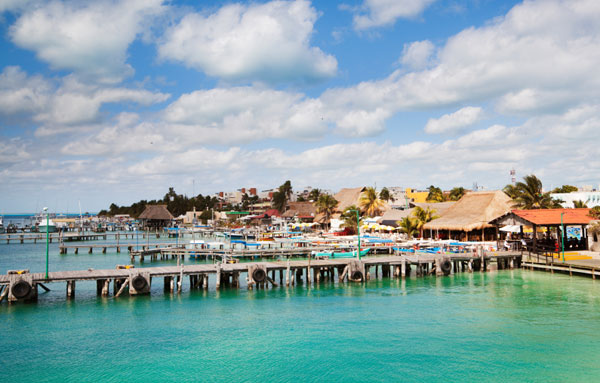Is Your Website a Secret Island?

An Oceanic Journey — the Spread of Your Influence
This journey begins with the words of David Amerland, in Chapter 9 of his book, “Google Semantic Search” . . .
“At the core of the semantic web lies the frequently mentioned transition from websites to people. This is the true ‘secret’ of semantic search and the hardest part to wrap one's head around.”
“The truth is that websites are not really the building blocks of the Web. Websites are portals through which data enters the Web. Data is the real building block of the Web.”
“If we visualize the Web as a sea, then the technology is ships and the websites are islands.”
“The early days of the Web were the age of sail when the technology we had was fairly inert and websites were static concerns that put all their energy just into being.”

“Today the technology is modern ships and the websites have become expensive resorts.”
Since the early days, the volume of content has grown. The massive amount of data that constantly enters the web needs to be indexed and understood for it to acquire real meaning. The tangled web of data flows from all directions and we can only see part of it. Much of the content that can be indexed just exists and is underused. It is hard to access and quantify. It is like a massive ocean growing under these apparently unconnected islands. Through search we begin to uncover, understand and access this data.
Building Trust on the Ocean
Trust used to be created on the Web when a larger island was linked to smaller islands. The smaller islands became more valuable. However, now that the way in which the links were acquired in the past is often suspect, paid link building strategies did not assist the genuine understanding of the content and use of the data. There must now become a way in which trust can be authentically built and the content of this ocean understood and explored.
Add “people” to this picture. People travel between islands, on ships, carrying goods, impressions, and information.
Some ships are like islands in themselves, in motion.

Mining the Ocean Depths
Google wants to understand the data. The way this is done is through the people. As the people visit the islands, buy from their shops, and bring their friends to vacation, the islands become known and successful. Real referrals of trust replace the old static mooring lines and crusted anchors buried in the ocean floor.
The private link building deals that some “islands” had with others are now replaced by the social signals generated by the people. The semantic search engine can read the signals, and index the valuable content of their messages and responses. The human-led activity is now called the “social signal” that has become a crucial part of the digital footprint of each company's marketing. The signal identifies the ocean's trade routes and forms the means for the discovery of the wealth of the content beneath.
The Measures of Value
The search engine looks into these signals to determine the strength of a company or brand, its value, and the trust of its visitors. These are the measures of quality used:
People — in volume, sharing their interactions
Frequency — co-citation happens whenever people mention a site's products and name
Freshness — how recent is the signal?
Depth — do the visitors stay on the surface or dive deeply into the content of the site, sharing valuable comments?
Breadth — how far do these signals spread through the social network to others?
Sentiment — what intentions do people convey about the content as they comment?
These signals share the visitor’s intent to the search engine. They are used by the engine to understand the meaning and importance of the content of that website. This enables value to be determined and ranking to be made. A piece of this ocean is unlocked. This ranking is real, based on the data coming from real people.
There must be a continuous stream of new data. Like the ocean, it must be in constant motion. This ongoing conversation will answer the question, “Why should I do business with you?” This is the process of building trust and ultimately influence.

How to Create Trade Routes
Similar to the development of piers and docks to tether boats coming to the island, visitors stopping along the way between the large islands begin to develop curiosity about your shoreline and inner waterways. You welcome these visitors and they tell others of your mysteries.
The role of an influencer is straightforward. The influencer may have a large following who may be interested in any content the influencer shares. The influencer may also have a following of other influencers, who in turn enjoy sharing that content with their followers.
Unlike the concept of marketing “targets,” online influencers appropriate to your island's magical secrets must be found and high quality relationships must be developed with care and respect.
Step 1— Identify the undiscovered magical properties of your island
List them and identify the special features and values of each one.
Step 2 — Find out who online tends to value and talk about these specific magical properties
List them, your influencers, and get to know each one.
Study their material, value their knowledge and share it with all you know.
Then uncover these magical properties for the influencers in return.
Step 3 — Invite your influencers to learn and value your island's magical properties
Assist them to learn about the magical properties and join in the sharing of their value.
Join with them in the further discovery of the true depths of these magical properties.
Note: to see “trade routes” on Google Plus, one need only click to view the ripples of a post to watch the circles of its engagers that formed over time.

The Cautions of the Sea Winds
An influencer’s reputation is built slowly and can be lost easily. Like navigation of the ocean, one must get to know the sea winds along your trade routes. Then, ultimately, the development of many quality relationships can band you and others together in mutual support in a new collaborative atmosphere online.
Establish trust, approach with care and build relationships.
Time is required, and there are no shortcuts.
Sustain engagement and ensure alignment of your brand and values.
Allocate your resources of time and money, for both paid and earned relationships.
Be honest, open, transparent, and authentic.
Engage in a helpful way.
Generate value for others.
This article is based on the guidance in the book, Google Semantic Search, by David Amerland. Please do enjoy the content of Chapter 9, the foundation for the article.
Please read the other articles in this series, based on this book:
You Are an Entity Not a Keyword
What on Earth is a Knowledge Graph
Passion and Customer Relationships Win at SEO
Local Landscaper Semantic Search Success Story
Why Would Google Recommend You?
Are You Actively Building Your Online Reputation?
Build a Business Dream Team on Google+
Dressing Your ENTITY for Success
Social Media for Semantic Search Success
The Secret to Making Your Business Successful Online

